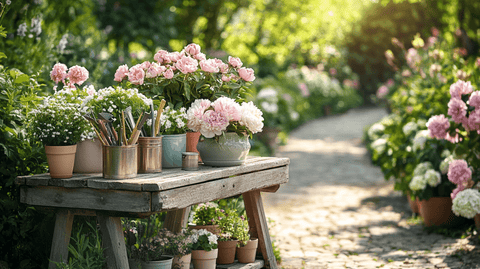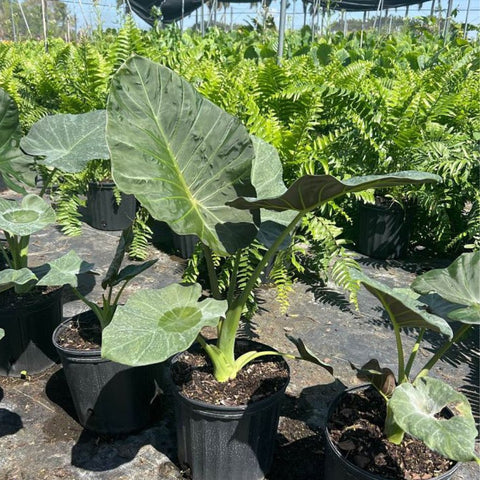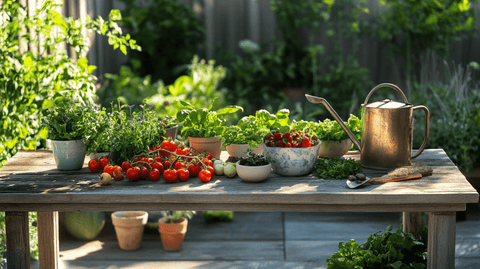Introduction
Spring is a season of renewal, promise, and the perfect time to delve into the world of gardening. The transformation from the chilly grays of winter to the vibrant greens of spring offers an invigorating opportunity for both novice and seasoned gardeners to nurture life's growth. Starting a garden in spring not only enhances your living space with beauty and color but also allows you to immerse yourself in the calming, rewarding cycle of tending to plants.

For beginners, gardening in spring can bring immense benefits such as relaxation, a chance to achieve self-sufficiency by growing your own produce, and fostering a deep connection with nature. At Plantology, we're thrilled to guide you on this journey with our wide range of plants and trees that are sure to ignite your passion for gardening.
Understanding the Basics of Spring Gardening
The Importance of Timing and Climate
Spring is quintessentially the best time for planting due to its temperate climate, adequate rainfall, and longer daylight hours. These conditions are ideal for cultivating a variety of plants as they emerge from dormancy and begin their life cycles anew.
Frost Dates and Their Influence
One critical factor in spring gardening is understanding your local frost dates. Frost dates are the calendar dates beyond which the risk of frost is minimal, marking the safe zone for planting sensitive plants. To avoid damage to your crops, ensure you plant after the last expected frost date in your area. This varies regionally and should be a key consideration in your gardening plan.
Essential Gardening Tools for Beginners
Before you start digging your hands into the soil, ensure you have the right tools. For beginners, it’s advisable to start with basic tools such as a hand trowel, pruners, a garden fork, and a watering can. Invest in quality tools that last, making your gardening experience smoother and more enjoyable.

Choosing the Right Plants for Your Spring Garden
Understanding Plant Hardiness and Soil Type
Selecting the right plants involves knowing their hardiness zones and soil preferences. Plant hardiness zones map out regional climates to guide you on plant survivability. At Plantology, we offer a variety of plants like the Adonidia Palm Single that thrive well in most spring settings.
Conducting a Soil Test
Before planting, perform a soil test to determine pH level and nutrient content. This can direct you on soil amendments needed for optimal plant growth.
Our Recommendations for Spring Plants
- Agapanthus Lily of the Nile Blue: Known for their stunning blue flowers that bloom beautifully in spring.
- Agave Blue: A resilient plant that adds an aesthetic edge to any garden with its unique rosette shape.
- Alexander Palm: Ideal for creating a tropical feel, this palm grows well in spring.
Step-by-Step Guide to Starting Your Spring Garden
Planning Your Garden Layout
Begin with a strategic plan for your garden layout. Consider sun exposure, plant heights, and spacing to ensure healthy plant growth and a visually appealing arrangement.
Preparing Your Soil
Enrich the soil by tilling and incorporating organic matter such as compost. This step is crucial as it improves soil structure, aeration, and nutrient content, creating a hospitable environment for your plants.

Planting Techniques and Tips
Direct Sowing vs. Transplanting
The method of planting may differ based on plant type. Some, like Agave Caribbean, are best transplanted, while smaller annuals can be directly sown into the soil.
Watering and Mulching
Water your new plants thoroughly after planting. Apply mulch around them to retain moisture, suppress weeds, and regulate soil temperature.
Ongoing Maintenance and Care
Understanding Watering Needs
Different plants have varying water requirements. Typically, the rule of thumb is one inch of water per week, which can be adjusted based on rainfall and individual plant needs. A product like the Aglaonema Silver Bay may require more specific watering routines.
Managing Pests and Diseases
Keep an eye out for common pests and diseases, especially as plants grow and temperatures warm. Implementing integrated pest management (IPM) can help maintain plant health without resorting to chemicals.
Biological and Mechanical Controls
Encourage beneficial insects, use barriers, and regularly inspect plants to keep pest issues at bay.

Enjoying the Fruits of Your Labor
Harvesting Tips
When it comes time to harvest, early mornings or evening times are ideal as the produce is freshest. For flowering plants, regularly deadhead spent blooms to promote continued flowering.
Replicating Success Across Seasons
Gardening is a learning journey. Take notes on what worked and what didn’t so you can build on your success season after season. Expand your garden with Plantology's diverse selection of quality plants that cater to both novice and expert gardeners.
Conclusion: Embrace the Joy of Gardening
Spring is your canvas, and gardening is the brush with which you can paint life into your surroundings. Whether cultivating produce for self-sufficiency or ornamentals for aesthetics, the journey is as rewarding as the destination. Take the plunge into a world of nature-filled bliss with the help of Plantology. Together, let’s nurture your budding green thumb, one plant at a time.
Ready to start planting? Explore our handpicked collection of easy-to-grow spring plants at Plantology and let the adventure unfold in your own backyard.
Expanding Your Gardening Knowledge
Spring is not only a time for new plants but also a perfect occasion for new learning. Understanding more about plant types, their specific needs, and eventually experimenting with different gardening techniques can vastly improve your success rate and enrich your gardening experience. Here, we provide insights to deepen your gardening expertise.

Diving Into Plant Biology
Understanding plant biology is crucial for successful gardening. Plants have different parts, each serving a specific function that can influence how you care for your garden. Recognizing the role of roots in anchoring plants and absorbing nutrients, leaves in photosynthesis, and flowers in reproduction can inform your watering, fertilization, and pruning practices.
The Role of Photosynthesis
Photosynthesis is the process by which plants convert sunlight into energy, crucial for growth. Ensuring that your plants have adequate light exposure, either through direct sunlight or via grow lights for indoor gardening, is paramount to their health and productivity.
Exploring Plant Families and Species
Diving into the taxonomy of plants can enhance your understanding of their care. The plant kingdom is vast, with various species divided into families based on common characteristics. Familiarity with plant families, such as the Asteraceae (daisies) or Solanaceae (nightshades), can provide insights into similar care requirements and potential pest or disease issues.
Increasing Biodiversity in Your Garden
Moving beyond a single type of plant and creating a diverse ecosystem in your garden can enhance resilience against pests and promote healthier growth through companion planting.

Companion Planting Basics
Some plants have synergistic relationships that can enhance growth when planted together. For instance, tomatoes and basil are known companions; basil can deter pests for tomatoes and enhance their flavor. Research and employ such strategies to improve plant health naturally.
Common Challenges and How to Overcome Them
Beginning gardeners often face challenges ranging from adverse weather conditions to pest infestations. Here, we delve deeper into common gardening issues and present practical solutions to help you maintain a thriving garden.
Weather Extremes and Their Impact
Spring weather can be unpredictable at times. Occasional temperature dips, unexpected heatwaves, or bouts of heavy rain may challenge your gardening efforts.
Protecting Plants from Late Frost
If a late frost is forecasted, cover your plants with fabric row covers or cloches to trap heat and protect young seedlings from the cold.
Dealing with Excessive Rainfall
Too much rain can lead to waterlogged soil, which deprives roots of oxygen and encourages fungal diseases. Ensure proper drainage in your garden area and consider elevating garden beds to reduce this risk.
Pest and Disease Control
Despite the best care, pests and diseases can still pose a threat to your garden's health.

Natural Pest Repellents
Consider using natural repellents such as neem oil or horticultural soap. Companion planting with pest-repelling plants like marigolds can also be effective in reducing pest populations.
Disease Resistant Varieties
Opt for disease-resistant plant varieties whenever possible. The choice of resilient species can significantly reduce the incidence of common diseases in your garden.
Embracing Seasonal Gardening Techniques
Each season provides different opportunities and requires specific gardening strategies. Embrace these techniques to maximize your output and enjoy a continuously thriving garden.
Seasonal Crop Rotation
Rotate crops to prevent soil nutrient depletion and break pest and disease cycles. This technique involves growing different crops in a specific order through the seasons.
The Benefits of Crop Rotation
Rotating your crops replenishes soil nutrients and reduces the buildup of soil-borne pests and diseases, ultimately leading to healthier plants and better yields.
Intercropping for Increased Yield
Consider intercropping - growing two or more crops together. This method can increase productivity and use space more efficiently, benefiting plants mutually.

Intercropping Examples
Pair fast-growing plants with slower ones, like lettuce with corn, to maximize light exposure and soil usage.
Innovative Gardening Trends to Try this Spring
Gardening, like any field, is influenced by trends. These innovations can offer new perspectives and techniques to incorporate into your garden this spring.
Vertical Gardening
Maximizing limited space is a key advantage of vertical gardening, which involves growing plants upward instead of outward.
Benefits and Examples
Utilize trellises, wall planters, or stacked pots to cultivate herbs, strawberries, or climbing vegetables like peas and beans.
Sustainable Gardening Practices
Focus on gardening methods that protect the environment and conserve resources.
Xeriscaping
Implement xeriscaping by using drought-resistant plants, minimizing water use, and incorporating mulches for moisture retention.
Using Technology in Gardening
Technology can simplify gardening tasks and improve precision.

Gardening Apps and Smart Devices
Use apps for plant care tips, or install smart watering systems that adjust based on soil moisture levels, optimizing water usage.
Conclusion: Continuing Your Gardening Journey
Spring represents a time of promise and new beginnings. As you embark on or continue your gardening journey, remember that each plant you nurture plays a part in connecting you to the natural world.
Through patience, exploration, and adaptation, your garden will flourish, providing beauty, sustenance, and a haven of tranquility. Whether you're growing luscious edibles or vibrant ornamentals, embrace the transformative power of gardening with the support of Plantology's diverse range of plants and gardening resources.
Get started today by exploring our handpicked, easy-to-grow spring plant selection at Plantology and discover how your garden can transform into a sanctuary of growth and life this season.






























Comments (0)
There are no comments for this article. Be the first one to leave a message!